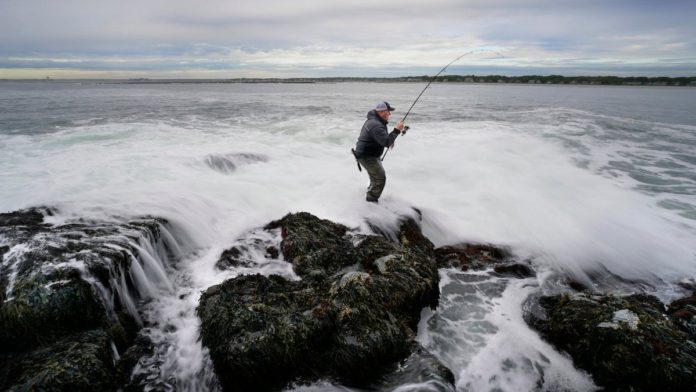It doesn’t matter if you’re throwing flys or plugs—if you want to catch more stripers this season, or catch the fish of a lifetime, the process doesn’t start with your first cast, it starts right now. From dialing in your gear to checking the tides and moon phases, there’s a lot to do now that will give you an edge this spring and summer. Here are some pre-season rituals that have helped me in my pursuit of stripers in the suds.
1) Define Your Striper Fishing Goals For the Upcoming Season
Before every season I like to define my goals. Goals can be simple like, I want to catch more fish, or I want to catch a 50-pound striper on a plug from the surf. They’re big-picture ideas that help put me in the right direction. However, they can be a bit pie-in-the-sky and they don’t help much when I’m trying to make the small everyday decisions that make up a successful season. That’s why I also like to make goals that are more specific.
For example, one goal I have for this upcoming season is to catch five fish over 30 pounds from just one small stretch of shoreline, which I’ve been working on learning for six seasons. A small goal like that helps me focus my priorities and forget other spots when necessary. It also helps me choose the best tactics and techniques in the moment.
Once I have about three to four goals written down for the season, I like to break down what went right and what when wrong during the previous season. Keeping and reviewing a fishing log is the best way to do this year after year.
2) Plan Out Your Striper Season With a Tide Calendar
While it can be hard to predict some factors five months out (like bait schools or Nor’easters), saltwater anglers have two things they can plan for: the tides and the moon phases.
Tide is the most important factor in most of my fishing spots. And the great thing about the tide is that you can look it up years in advance. The same goes for moon phases. The few days around the new and full moons can be the most productive of each month, and you can look those dates up right now.
When I begin planning my summer, I’ll make a few assumptions based on experience, start identifying key tides around the moons, and make a calendar. I use a digital calendar for the spots that fish best during certain tides, moon phases, and seasons. For example, if I have a spot that fishes best on an incoming tide during the few nights around the full moon and this lasts all summer long, I look up all the nights during the summer that coincide with incoming tides that fall within roughly four or five days of the full moon and mark them down now.
A calendar helps me plan when I need to take time from work or reschedule other obligations. It also helps me make decisions about fishing at one spot over another. When you’re doing this kind of planning, I suggest picking just a few spots based on your goals. You’d be surprised how much time a handful of spots can eat up in a season—especially if you’re only fishing a couple nights a week. If your calendar does fill up, don’t get overwhelmed. Even if there is a lot of overlap between different fishing spots, having it all laid out will help you prioritize.

3) Scout New Fishing Spots and Reconnect With Old Ones
Another part of my pre-season checklist is to visit any spots—new and old—that I’m trying to learn or think I should re-examine. I’ll go without a fishing rod, and take time to observe. I’ll usually walk a stretch of shoreline, watch the tide, and look for how the water moves around structure.
Scouting is really important if you fish soft structure. Areas like sand beaches or inlet mouths can change dramatically over the winter due to large tides and storms. And you never want to be surprised and unprepared on your first tide out.
Regardless of structure I suggest visiting your spots at two different times. First, go at low tide when you can get the clearest look at the structure, and second, during the tide phase when you’ll actually fish. A lot of anglers just scout during low tide, and this can mean missing vital clues like the strongest currents, ambush points, or current seams.
Finally, I also spend a lot of time on both Google Earth and Navionics during the winter. I use Google Earth to get an overhead view of my spots. The “back in time” tool, which allows you to view historical imagery, can be particularly useful, too. It allows me to view any changes to my fishing spots, and I can often get glimpses of my spots at different tide stages
I like to use Navionics to scout for depth contours and identify edges and drop-offs I may not be able to see from shore. It’s also great for measuring casting distances when used in concert with the satellite overlay. I do this by changing the settings to Bing Maps imagery, with the contour lines still visible. Then, I can measure using the distance tool and find out where my lure or fly is landing from different casting positions. I’ll use all this to seek out new spots, but also hone and refine my very best.
Read Next: The 10 Reasons You’re Not Catching Big Striped Bass in the Surf
4) Prepare Your Fishing Gear for Battle
Another absolutely critical step in preparing for the season is checking over all your gear and making sure it’s in tip-top shape. Service your reels to make sure the drags are working flawlessly, and check your rods for weak or damaged hardware and repair if necessary. Lure hardware and lines, which are often neglected, are arguably the most important parts of any surfcaster’s kit. The hooks, split rings, snaps, and line are what connect you to the fish. Trophy-sized fish are powerful, and they will test even the most well-maintained gear; especially if you’re fishing strong current, like inlets, or around lots of hard structure, like boulder fields.

Before the season, I also like to go over almost every single one of my lures and flies and check the hooks and other associated hardware. I’ll toss any fly that has a dull hook that can’t be sharpened. With lures, I’ll swap out any rusty, bent, or dull hooks. And while I will spend time sharpening hooks during the season, I generally just remove any hook in the winter that’s even a little dull and start fresh. Hooks are so important that I’m fine spending a little bit more money to swap them out instead of skimping and rolling the dice. The same goes for split rings. Since they’re so cheap, if I even suspect one might be getting worn, I’ll change it. This all takes hours each winter, but it’s crucial.
Finally, I like to swap out all my fishing line prior to a new season. I only use braid in the surf, and it holds up well to typical use, but I always feel better starting with new line each spring. You may be able to get several years out of your line, especially if you’re only fishing in areas with sand. But it’s worth doing a thorough check to see what kind of shape your line is in. As for leaders, I don’t make a lot ahead of time, but it’s a great activity to do while watching TV. Tying a few every night can pay off at the start of the season.
Credit: Source link





























